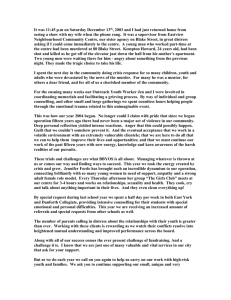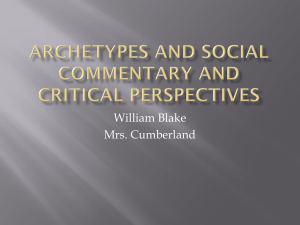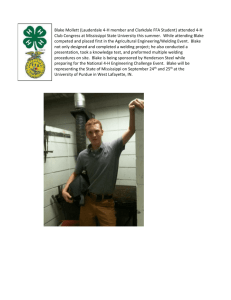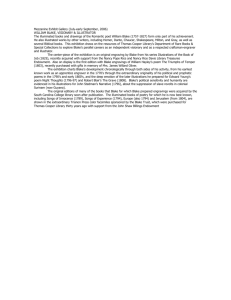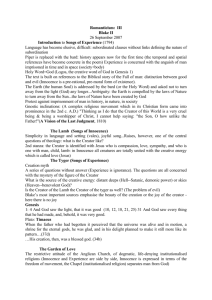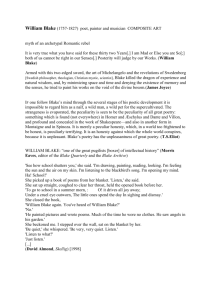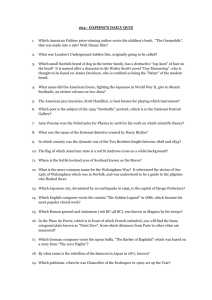The Book of Urizen
advertisement
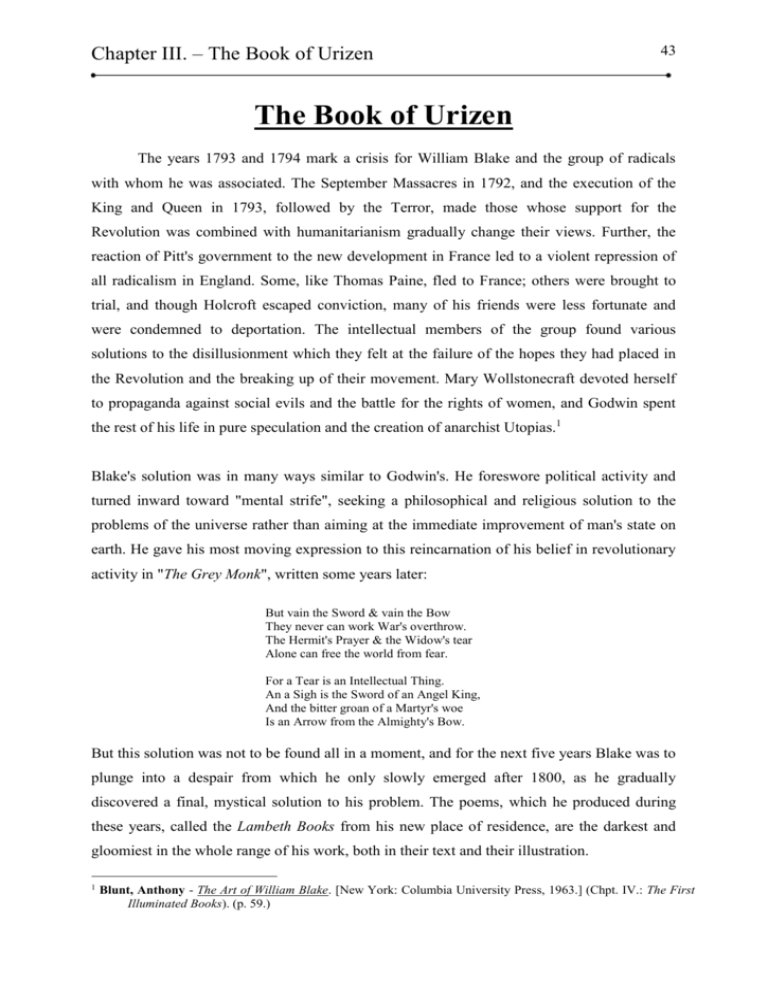
Chapter III. – The Book of Urizen 43 The Book of Urizen The years 1793 and 1794 mark a crisis for William Blake and the group of radicals with whom he was associated. The September Massacres in 1792, and the execution of the King and Queen in 1793, followed by the Terror, made those whose support for the Revolution was combined with humanitarianism gradually change their views. Further, the reaction of Pitt's government to the new development in France led to a violent repression of all radicalism in England. Some, like Thomas Paine, fled to France; others were brought to trial, and though Holcroft escaped conviction, many of his friends were less fortunate and were condemned to deportation. The intellectual members of the group found various solutions to the disillusionment which they felt at the failure of the hopes they had placed in the Revolution and the breaking up of their movement. Mary Wollstonecraft devoted herself to propaganda against social evils and the battle for the rights of women, and Godwin spent the rest of his life in pure speculation and the creation of anarchist Utopias.1 Blake's solution was in many ways similar to Godwin's. He foreswore political activity and turned inward toward "mental strife", seeking a philosophical and religious solution to the problems of the universe rather than aiming at the immediate improvement of man's state on earth. He gave his most moving expression to this reincarnation of his belief in revolutionary activity in "The Grey Monk", written some years later: But vain the Sword & vain the Bow They never can work War's overthrow. The Hermit's Prayer & the Widow's tear Alone can free the world from fear. For a Tear is an Intellectual Thing. An a Sigh is the Sword of an Angel King, And the bitter groan of a Martyr's woe Is an Arrow from the Almighty's Bow. But this solution was not to be found all in a moment, and for the next five years Blake was to plunge into a despair from which he only slowly emerged after 1800, as he gradually discovered a final, mystical solution to his problem. The poems, which he produced during these years, called the Lambeth Books from his new place of residence, are the darkest and gloomiest in the whole range of his work, both in their text and their illustration. 1 Blunt, Anthony - The Art of William Blake. [New York: Columbia University Press, 1963.] (Chpt. IV.: The First Illuminated Books). (p. 59.) Chapter III. – The Book of Urizen 44 Blake's bitter awareness of the evil of the world led him to a dualist belief which insisted on the existence of an original force of evil, which he called Urizen.2 The name "Urizen" comes from the Greek , "to fix a limit" and is identified with the Jehovah (IHVH) of the Old Testament by Blake in opposition to Jesus of the New Testament, whom he identified with the force of good. This basic opposition he extended by adding to UrizenJehovah the attributes of reason, restraint, and law, as opposed to imagination, freedom, and love for one's neighbour, which he associated with Christ. The [First] Book of Urizen is known in seven copies, containing from 24 to 28 plates plus some scattered plates – including the title page and ten full-page designs. The first copy was published in 1794. As in the Bible, the text is divided into two columns and set out in chapters and verses. Designs are chiefly restricted to blocks at top or bottom of the page, often however filling more than half the page and dominating it. The figures are often gruesome: a crouching skeleton, for example, or the blind Urizen opening his book of corruption. Earth, air, fire, and water become elements of oppression and death. Only a few of the designs are lighter and more hopeful. Blake's theme now is not the overthrow of tyranny, but a horrified fascination with its origin. The Book of Urizen – written in a rough anapaestic trimeter3 – is Blake's Genesis, and the core of his Bible of Hell, re-shaping the Fall and the Creation of the physical universe. It is also the locus for his mythology in 'A Song of Liberty', America, Europe, The Song of Los, The Book of Ahania and The Book of Los, all of which rest on the ideas presented in this poem. Urizen, like Milton's Satan, was an angel enjoying the immoral life, though among democracy of immortals. He is not cast out for rebellion against law, but separates himself by demanding that Law be established. Los, the immortal artist, emerges to define, clarify and make sense of the disaster, by the power of imagination. Blake works in many more allusions. Los becomes Adam, and Enitharmon his Eve. Orc is born to her, like Cain, but also the Serpent. 2 The name "Urizen" was pronounced by Blake with primary stress on the first syllable (not on the second). For the clear metrical evidence see: Metcalf, Francis Wood – "The Pronunciation of Blakean Names" in Blake Newsletter 21. [1972.] (pp. 17-18.) 3 Keynes, Geoffrey (ed.) - The Complete Writings of William Blake. [Oxford: Oxford Universitiy Press, 1996.] (p. 913.) Chapter III. – The Book of Urizen 45 The storyline of the poem is as follows: Urizen – a god of Reason who separates himself from other Eternals, demands obedience to his self-proclaimed principles, and falls into Chaos – is an abstract, vain and punitive deity. A body is created for him by Los, 'the eternal prophet' or Divine Imagination. But Los, exhausted, divides into male (Los) and female (Enitharmon). Their child Orc – who represents Rebellious Energy – is born but immediately chained to a rock. Urizen then explores his deadly world, and mankind shrinks up from Eternity. Finally, some of Urizen's children begin an exodus. It is important to note that for Blake the Creation and the Fall are one event. This event occurs in stages, each of which shows unity lapsing into duality and spiritual energy lapsing into material passivity. Humanity as we know appears only at the very end of a long cataclysmic process, and is – from the point of view of Eternity – almost wholly pathetic. In Urizen, Apocalypse is genesis; creation is fall – conflations that obviously clash with the logical flow of the biblical (and Miltonic) hexameral paradigm. Urizen, at the centre of both binaries, additionally confounds the reader who expects a Manichean division of good and evil in the characters. 4 Understanding the text thus must necessarily be a recursive act. Urizen cannot be read – it can only be re-read. Yet, a distinct temporal progression does characterize the events of Urizen. The narrator's response to the muse-like Eternals "I hear your call gladly,/ Dictate swift winged words" [Prel:5-6]5 suggests that the process of composition proceeds in a continuous (hence linear) manner. Structurally the book also evinces a recognizable architecture: the title page submits to the preludium, which precedes sequential chapters, each subdivided and numbered. Fibres and chains, webs and nets: Blake's illuminated poetry is replete with objects that snag and bind. Nearly every character in The Book of Urizen is caught up in something; Los nets and binds Urizen [8:6], Enitharmon and Urizen chain Orc [20:20]; the Web of Religion enmeshes all [25:20]. The reader, too, finds navigation difficult; the collapsed temporal framework of Blake's cosmogony thwarts the linear, easy read. This dialectic between bookish linearity and conceptual chaos is not, of course, abnormal in Blake, a writer who fuels his works with the friction of opposition. But the tension between linearity and nonsequentiality (or multi-sequentiality) in the text of Urizen is exacerbated by the illustrations, 4 The "bounding line": Verbal and Visual Linearity in Blake's "Laocoön" and Book of Urizen. [http://www. mindspring.com/~jntolva/blake/#5] 5 All Blake quotations are from Erdman, David V. - The Complete Poetry and Prose of William Blake. [New York: Doubleday, 1988]. In-text references to poems cite first the plate then the line number. Chapter III. – The Book of Urizen 46 all of which deny interpretation as mere portrayals of the textual narration. Not all the plates, for example, depict scenes mentioned in (or even suggested by) the text itself. (The title page is a good example of this. Urizen as writer of course is a major theme in The Four Zoas, though it is only alluded to in Urizen.) The most obvious subversion of order is the fact – as W.J.T. Mitchell has noted – that ten of the plates are full-page illustrations and that their order is different in each of the seven extant copies of Urizen. Mitchell sees this "atemporal, antisequential quality" as a "deliberate formal device, a way of augmenting the anti-narrative elements disclosed by the text."6 And yet, again, the book maintains a certain fixity: the title page, preludium, and (most of) the textual plates follow in the same basic sequential order in all copies of the poem. So, it seems that linearity in Blake's Urizen inheres neither in the text nor in the images but rather in the format of the book itself. This tension is a function of a narrative constrained by its own materiality. No one knows for sure how to proceed through The Book of Urizen. That is, none of the seven extant copies of the illuminated books is composed of plates arranged in the same order. At this most basic level there is a sense that Blake toyed around with the meaning of linear progression through his textual picture book. It inheres in multiplicity, for the various and tangled narrative lines in Urizen can bewilder the reader and stymie the sense of a logical flow. Commenting on the motif of the "Fibrous form" (one of many kinds of organic filaments in Blake's poem), Mitchell notes that the "temporal manifestation of this form is the structure of intricate, labyrinthine interplay between various narrative lines, and the feeling that our movement through the poem is like watching the uncontrolled growth of a cancer, an explosive series of mitoses, divisions, and subdivisions, or the proliferation of genealogical ‘branches' from a single root."7 The narrative lines in Urizen – of the Eternals, of Urizen, of Los, and of Enitharmon – do not merge into a singularly definable narrative "trunk"; they are rather separate and discrete (though they do intersect). In a word, Urizen is multi-linear. One "storyline" constructs Urizen as the God of creation whose "Words articulate" "rolled on the tops of his mountains"[4:4-5]; another fashions a demonic, fallen Urizen, "Unseen in tormenting passions;/ An activity 6 Mitchell, W.J.T. - Blake's Composite Art: A Study of the Illuminated Poetry. [Princeton, N.J.: Princeton University Press, 1978] (p.137.) 7 Mitchell, W.J.T. - Blake's Composite Art: A Study of the Illuminated Poetry. [Princeton, N.J.: Princeton University Press, 1978] (p.130.) Chapter III. – The Book of Urizen 47 unknown and horrible;/ A self-contemplating shadow"; another depicts Urizen as the Adamic first human "rent from Eternity," a "clod of clay"[6:8-10]. Navigating these lines requires surrendering the very notion of line, for to follow a particular line to its end is to be led astray, or not to be led anywhere. Only by moving associatively through the forest of signification can sense be constructed. The figure of Urizen (and the other polymorphous characters) literally is the intersection of these storylines, a kind of node moving among the bifurcating elements of the narrative. Nelson Hilton believes that Blake was aware of textual accordioning to the extent that his word "fold" is a self-conscious referent. Hilton describes the spatializing feat that the reader must execute in trying to manoeuvre the narrative lines of Urizen: "To stave off the madness of proliferating extensions and regression, we "chunk," or shrink, together the levels not directly before us... As words have no direct relation to things, so the "chunks" of image, belief, perception, and so on have no direct relation to reality; perception becomes a localized function of past and present environment."8 Reality here corresponds to the material artefact that is the book of Urizen. Perceptually we distort the neat physical lines of the book; we crumple them together in order to perform the most basic readerly task of understanding the poem. We must effect a stasis like Urizen in plate six, one that cuts across the lines of signification, rather than hanging ourselves in them like the figures in the next plate. As the agents of the perception, we readers stand at the centre of a tangle of lines, echoing Urizen caught in the Web of Religion. 8 Hilton, Nelson - Blakean Zen . [in Studies in Romanticism 24. (Summer 1985.)] (p.184.)
